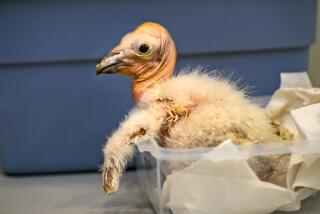Audubon bird counters ‘appreciate the fragility’ of nature
Georgene Foster started paying attention to birds in 1966 after she moved into a Rolling Hills Estates home with a big window.
“At breakfast, I noticed a gray bird that had a white hat on,” she said. “I went to the library and got a bird book and found out it was a white-crowned sparrow. I went on from there.”
Robert Carr, who teaches science at South High School in Torrance, spent a summer working on a duck census for the state of New Hampshire after graduating from college. That was in 1958, and he’s been keeping track of birds ever since.
With binoculars and bird books ready for action, the two birders will join the crowd tramping coastlines, canyons, parks and nature preserves on Saturday to tally the number and variety of South Bay birds. For some, the treks will start before daybreak.
The occasion is the 24th annual Christmas bird count of the Palos Verdes Peninsula Audubon Society, in which people in 10 different groups will spend all day covering a circle with a 15-mile diameter centered on the Palos Verdes Reservoir.
Among the areas being covered are the South Coast Botanic Garden, the Palos Verdes Golf and Country Club, Harbor Lake in Harbor City and the Ft. MacArthur Upper Reservation in San Pedro.
Although birders like Foster and Carr can identify a bird before the average pair of eyes even sees it, anyone who wants to spend a day in the wilds is welcome.
“We like to introduce people to natural areas and birds,” said Audubon Society President Jess Morton, explaining that the society aims for a mix of experienced bird watchers and novices still prone to confuse a bird with a leaf.
“What’s really good is that people can drop in and out of the groups. It’s not an endurance thing,” said Shirley Borks, an Audubon board member who has been on four bird counts. “Last year, I met people who had never gone before. They were in awe of all the people who knew all the birds.”
If the bird count is intended to be a lark for the participants, it has a very serious purpose. The South Bay count is part of the nationwide survey of American winter birds sponsored by the National Audubon Society.
The national project started in 1900, when the editor of a bird magazine decided that appreciating and counting birds would be better than the then-fashionable practice of going out at Christmastime and shooting them.
Said Morton: “We take aim, but we see and learn.”
According to Audubon members, the counts have been used to produce maps showing bird distribution and how it has changed over the decades. The surveys have pinpointed where birds are declining and identified threatened habitats that conservationists can, in turn, take steps to protect.
In the South Bay, the Palos Verdes Audubon group count has shown a steady decline in birds that require open fields for nesting and food. Increasing development has destroyed these areas, and Morton said the lovely song of the meadowlark is being heard less and less. “Quail and pheasant used to be abundant,” he said. “We’ve had trouble finding any quail on the last two or three counts.”
On the other hand, the hearty house finch is more abundant--”they can nest in the desert or in your mailbox”--as are hummingbirds. They thrive on the nectar of plants and flowers around homes.
On Saturday, each group will be led by an expert thoroughly familiar with habitats. People who wish to join a bird count group may call Ross Landry at 863-9078 or Dave Bradley at 498-0370. Comfortable walking shoes and warm clothing are advised.
Landry, one of the group leaders, said experienced birders know the territory so well that nothing they spot Saturday will surprise them. What everyone hopes for, he said, is seeing something that’s not supposed to be there. “If they see something unusual for the area, it’s a real event,” he said.
Birders say the real fun lies in being able to identify a bird. And often, they recognize it by hearing its song long before they see it. Morton said the challenge is “learning to believe what you see and hear” even when a bird disappears so fast that you think it may have been an illusion.
A sense of conservation and respect for nature also comes with the hobby. Said Carr: “You learn to appreciate the fragility of what you see. Habitats are being reduced, and if you lose the habitat, you lose the bird.”
While the etiquette of birding is a kind of concentrated quiet, discussions about a bird’s identity can become intense. The plumage of some young birds is easily confused, and some can imitate the songs of several other birds.
And people have been known to play jokes on the annual count. One year, someone came early and put fake birds in a tree. When the group got there, the man pretended he’d found a strange new bird.
Said Foster: “He fooled everyone for a few minutes.”
More to Read
Sign up for The Wild
We’ll help you find the best places to hike, bike and run, as well as the perfect silent spots for meditation and yoga.
You may occasionally receive promotional content from the Los Angeles Times.






